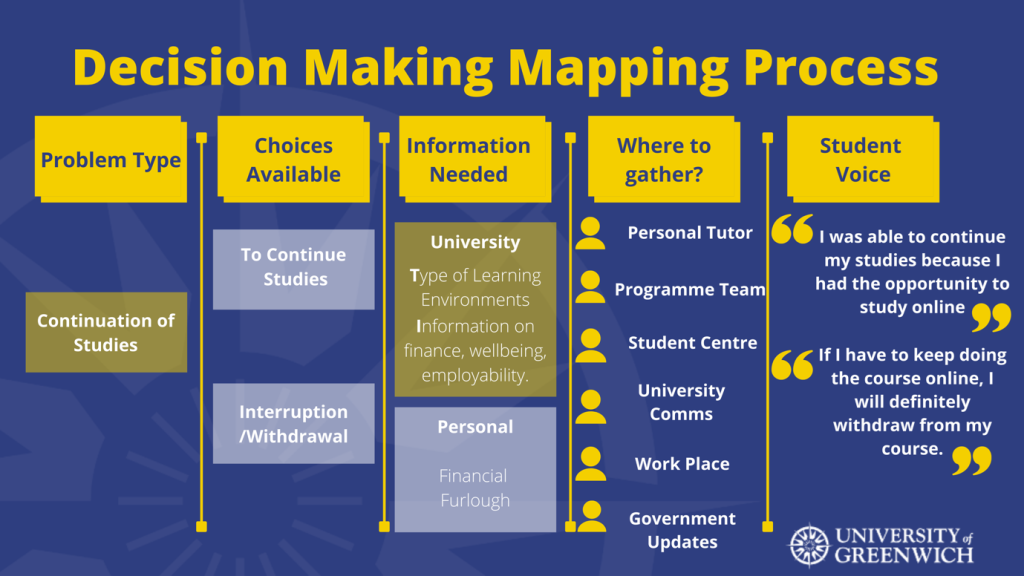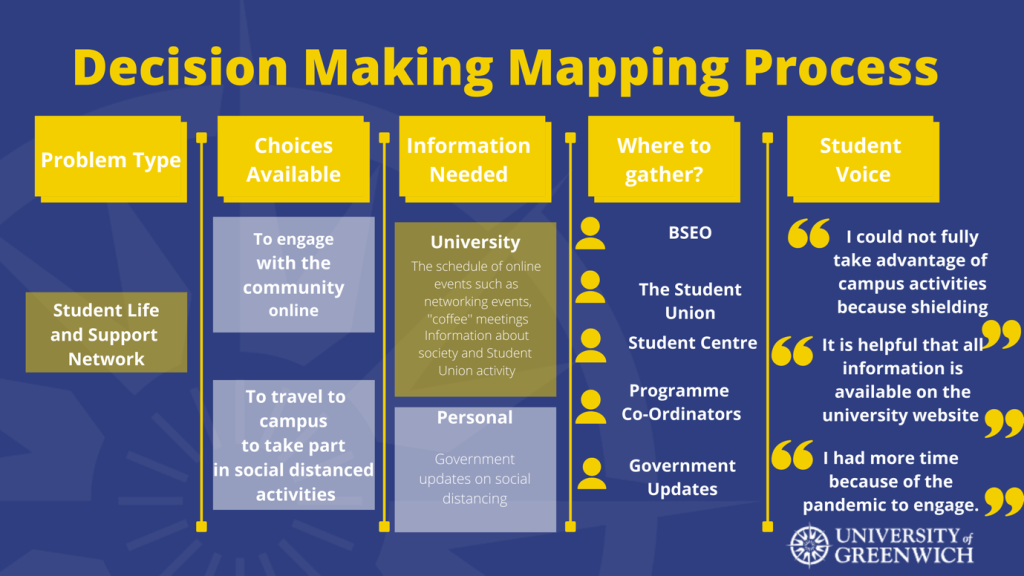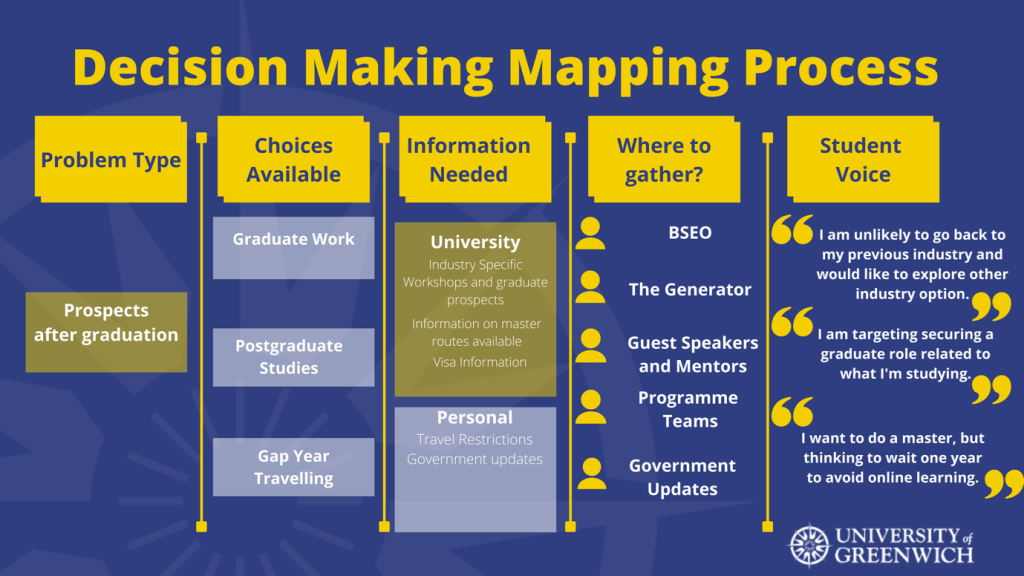Four ways in which we can collaborate to better support students in their decision-making process.
At the 2021 University of Greenwich Teaching and Learning festival, we presented the findings of our research focused on decision-making under uncertainty, looking at how university students navigate the academic implications of the COVID-19 pandemic. Our university adapted to the pandemic by initially adopting a blended approach to teaching and learning, and later transitioning to full online delivery. The quick and dramatic transition from on-campus to online learning caused major disruptions to both staff and students at the university. Our presentation explored students’ experiences, making sense of the effects of the pandemic on their university lives and their strategic decision-making responses.
In the literature, we identified that when faced with decision-making under uncertainty, as with the COVID-19 pandemic, students seek different sources of information related to the particular issue (Moogan, 2020). The literature highlighted the importance of academic and professional services support as students seek information on several issues. These issues included, their studies, counselling, career development and university guidelines related to the COVID-19 pandemic impact on their university studies/experience. This created challenges which the university had to respond to with effective solutions to students’ concerns to ensure they were supported in their decision-making.
We adapted the decision-making process map by Towler (2010) to understand the issues students experienced in dealing with the impact the COVID-19 pandemic on their academic life, and how they gather and evaluate the information needed to reach the optimal solution to these. Through five focus groups organised with 30 students at different academic levels, aged between 21-35 years, both home and international students and both BAME and white students, we managed to identify five main themes representing the challenges and problems they faced, that are later developed in process maps:
- Continuation of Studies,
- Type of Learning Environment,
- Part-Time Work to develop transferable skills or financial support,
- Student Life and Support Network, and
- Prospects after Graduation.

Decision Making Mapping Process: Continuation of Studies (Created by Raluca Marinciu)
The first decision process map focuses on continuation of studies. During the pandemic, students have been faced with the decision of whether to continue their studies or interrupt/withdraw from their programmes. Students felt they needed information about the type of learning environments that are available to them, information on how they could continue financing their studies, their wellbeing, including access to relevant services, and employability prospects. They needed to gather personal information, such as their financial situation in the pandemic and in some cases whether their part-time work would offer them furlough. Each student tried to find the best way to get that information, with most of them deciding on liaising with their personal tutor, programme team and/or student centre. Others relied on university communications, workplace announcements, and government updates. When informed about alternative learning environments, some said that they were able to continue their studies they were pursuing, thanks to online study, whilst others felt that they would withdraw, should online learning continue beyond the current academic year.

Decision Making Mapping Process: Learning Environment (Created by Raluca Marinciu)
The second decision process map focuses on the learning environment. At the beginning of the academic year, students had to choose between blended learning and online learning. The type of information that students needed in making this decision was the flexibility of delivery, the digital resources available to them and how assessments were adapted to fit an online delivery, as well as information on accommodation and COVID-19 social distancing rules on the campus. Students needed to seek information about their access to technology, as some students suffered from digital poverty due to limited connectivity at home. International students also had the challenges of different time zones when connecting their online classes. Students relied heavily on personal tutors, programme team, and the student centre as their sources of information. Other students went to communications from the university and informative sessions to learn about the delivery mode. When asked about their learning environment, some students felt they benefited from the pre-recorded lectures as they could learn at their own pace, others preferred blended learning to get the best out of the university experience and meet new people.

Decision Making Mapping Process: Part Time Work (Created by Raluca Marinciu)
The third decision process map focuses on part-time work. The students had to face decisions on their employment during their studies. The decisions were whether they should consider working, to find a new part-time role if they had been made redundant or to continue in a previous job if they had been on furlough. Whilst discussing this with students, it became evident that they took part-time roles, not only to support themselves financially, but to develop their skillsets and transferable skills. Therefore, when faced with this decision, students needed information on the types of virtual internships provided and volunteering opportunities that could replicate the skills development. They also were seeking information about employability, “side-hustles” and entrepreneurship. The students were looking for government updates on furlough and job retention. When asked where they first went to look for information on employment concerns, the students’ responses were the Business School Employability Office and The Generator (a centre that promotes entrepreneurship at the University of Greenwich). Some students followed up with other resources such as Student Centre, industry reports or government updates. Some students shared that to compensate for the skills they would have developed through part-time employment, they did virtual internship or volunteered for charities. Other students retained their jobs in hospitality through the furlough scheme provided by the government.

Decision Making Mapping Process: Student Life and Support Network (Created by Raluca Marinciu)
The fourth decision map focuses on student life and support network. Students’ two options were either to engage with the Greenwich community online, or to travel to campus to take part in socially distanced activities. To make this decision, students looked at the university’s schedule of online events, such as, virtual networking events, virtual coffee mornings, and other student union activities and compared these with similar on-campus offerings. In this instance, when deciding the best option, students relied on government updates for social distancing and advice on keeping safe during the pandemic, also taking into consideration their extended network. When looking at where students went to find out this information, we discovered they were checking BSEO and Student Union event schedules as a primary source of information. They also made enquires with the Student Centre and programme co-ordinators. Government updates were important in their decision-making on how to keep themselves safe. Some students thought they could not take advantage of campus activities because they were shielding, whilst others felt that the pandemic had a positive impact on their engagement with extra-curricular activities as result of having more free-time.

Decision Making Mapping Process: Prospects after graduation (Created by Raluca Marinciu)
The fifth decision map looks at prospects after graduation, where students were faced with three main options: find graduate work, continue with postgraduate studies, or take a gap year to go travelling. The types of information the students looked at to make this decision were industry-specific graduate prospects, as well as information on postgraduate routes available and visa information. With this option, students had to keep updated on travel restrictions and government updates concerning lockdowns. When asked where they went to gather this information, students said they relied on the BSEO and guest speakers, as well as mentors, to get them the most up-to-date information on their chosen industry and whether a graduate route is viable during this point in the pandemic. Furthermore, some students also explored entrepreneurship routes with the help of The Generator, as well as getting information from the programme teams about potential postgraduate routes. Some students felt they wanted to explore new industries due to the pandemic, whilst others felt postgraduate studies could give them the greatest benefit since it would delay their entry into the job market which has been adversely affected by the Covid-19 pandemic.
We would like our blog to be a call to action to improve the services and support that our students get in their decision making. We have identified four main areas from our findings where universities could direct their efforts.
- Tailored communication approach: We have identified that students have different needs at different levels or circumstances. How can we best tailor our communications to different types of students?
- Community feeling: Students feel that online delivery lacks a community feeling. How can we make students feel a sense of being a part of a community online?
- Connecting students to professional services: We have identified the importance that professional services play in students’ journeys. How can we best connect students to professional services?
- Employability: After the impact of the pandemic, employability has become a priority and concern for our students. How do we best collaborate to support students in their professional development?
Although self-reported mental health should not automatically be interpreted as an increase in mental illness or need for mental health services (ONS, 2021), to support students during this difficult time we recommend that universities should allocate more resources in mental health services and increase communication to reduce barriers. Expansion of counselling services (including tele-counselling programs) during the pandemic is highly recommended. The engagement of academic staff, particularly personal tutors, is also important to disseminate information, providing pastoral care and academic support. We also recommend having support classes in every module to mitigate students’ anxiety and depression (a comprehensive review of student’s mental health and recommendations can be found in the study of Storrie, Ahern and Tuckett, 2010).
Blog Authors
Dr Sterling Rauseo
Lecturer
Department of Human Resources and Organisational Behaviour
Greenwich Business School
s.rauseo@greenwich.ac.uk
Diluk Rathnayake
Teaching Fellow
Department of Human Resources and Organisational Behaviour
Greenwich Business School
d.v.rathnayake@greenwich.ac.uk
Raluca Marinciu
MBA Employer Engagement and Placement Manager
BSEO
University of Greenwich
r.marinciu@greenwich.ac.uk
References
Moogan, Y. J. (2020) An investigation into international postgraduate students’ decision-making process. Journal of Further and Higher Education, 44(1), 83–99. https://doi.org/10.1080/0309877X.2018.1513127
Office for National Statistics (2021) Coronavirus and higher education students: England, 19 to 29 November 2021. Available at: https://www.ons.gov.uk/peoplepopulationandcommunity/healthandsocialcare/healthandwellbeing/bulletins/coronavirusandhighereducationstudents/england19to29november2021 (Accessed: 26th January 2022)
Storrie, K., Ahern, K. and Tuckett, A., (2010) A systematic review: students with mental health problems—a growing problem. International journal of nursing practice, 16(1), pp.1-6.
Towler, M. (2010) Rational decision making: An introduction. New York, NY: Wiley.